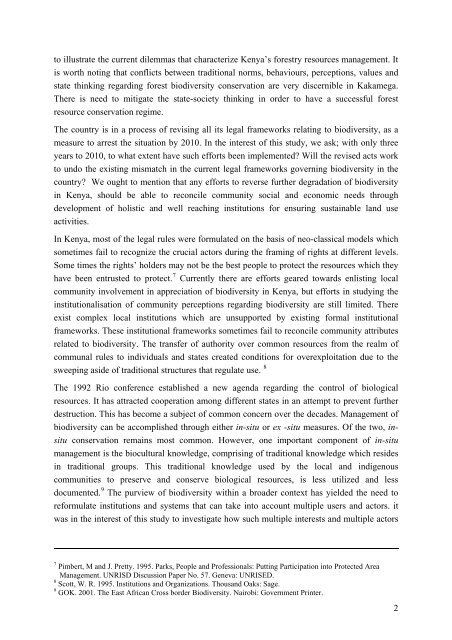THE UNIVERSITY OF LEIPZIG
THE UNIVERSITY OF LEIPZIG
THE UNIVERSITY OF LEIPZIG
Create successful ePaper yourself
Turn your PDF publications into a flip-book with our unique Google optimized e-Paper software.
to illustrate the current dilemmas that characterize Kenya’s forestry resources management. It<br />
is worth noting that conflicts between traditional norms, behaviours, perceptions, values and<br />
state thinking regarding forest biodiversity conservation are very discernible in Kakamega.<br />
There is need to mitigate the state-society thinking in order to have a successful forest<br />
resource conservation regime.<br />
The country is in a process of revising all its legal frameworks relating to biodiversity, as a<br />
measure to arrest the situation by 2010. In the interest of this study, we ask; with only three<br />
years to 2010, to what extent have such efforts been implemented? Will the revised acts work<br />
to undo the existing mismatch in the current legal frameworks governing biodiversity in the<br />
country? We ought to mention that any efforts to reverse further degradation of biodiversity<br />
in Kenya, should be able to reconcile community social and economic needs through<br />
development of holistic and well reaching institutions for ensuring sustainable land use<br />
activities.<br />
In Kenya, most of the legal rules were formulated on the basis of neo-classical models which<br />
sometimes fail to recognize the crucial actors during the framing of rights at different levels.<br />
Some times the rights’ holders may not be the best people to protect the resources which they<br />
have been entrusted to protect. 7 Currently there are efforts geared towards enlisting local<br />
community involvement in appreciation of biodiversity in Kenya, but efforts in studying the<br />
institutionalisation of community perceptions regarding biodiversity are still limited. There<br />
exist complex local institutions which are unsupported by existing formal institutional<br />
frameworks. These institutional frameworks sometimes fail to reconcile community attributes<br />
related to biodiversity. The transfer of authority over common resources from the realm of<br />
communal rules to individuals and states created conditions for overexploitation due to the<br />
sweeping aside of traditional structures that regulate use. 8<br />
The 1992 Rio conference established a new agenda regarding the control of biological<br />
resources. It has attracted cooperation among different states in an attempt to prevent further<br />
destruction. This has become a subject of common concern over the decades. Management of<br />
biodiversity can be accomplished through either in-situ or ex -situ measures. Of the two, insitu<br />
conservation remains most common. However, one important component of in-situ<br />
management is the biocultural knowledge, comprising of traditional knowledge which resides<br />
in traditional groups. This traditional knowledge used by the local and indigenous<br />
communities to preserve and conserve biological resources, is less utilized and less<br />
documented. 9 The purview of biodiversity within a broader context has yielded the need to<br />
reformulate institutions and systems that can take into account multiple users and actors. it<br />
was in the interest of this study to investigate how such multiple interests and multiple actors<br />
7 Pimbert, M and J. Pretty. 1995. Parks, People and Professionals: Putting Participation into Protected Area<br />
Management. UNRISD Discussion Paper No. 57. Geneva: UNRISED.<br />
8 Scott, W. R. 1995. Institutions and Organizations. Thousand Oaks: Sage.<br />
9 GOK. 2001. The East African Cross border Biodiversity. Nairobi: Government Printer.<br />
2






